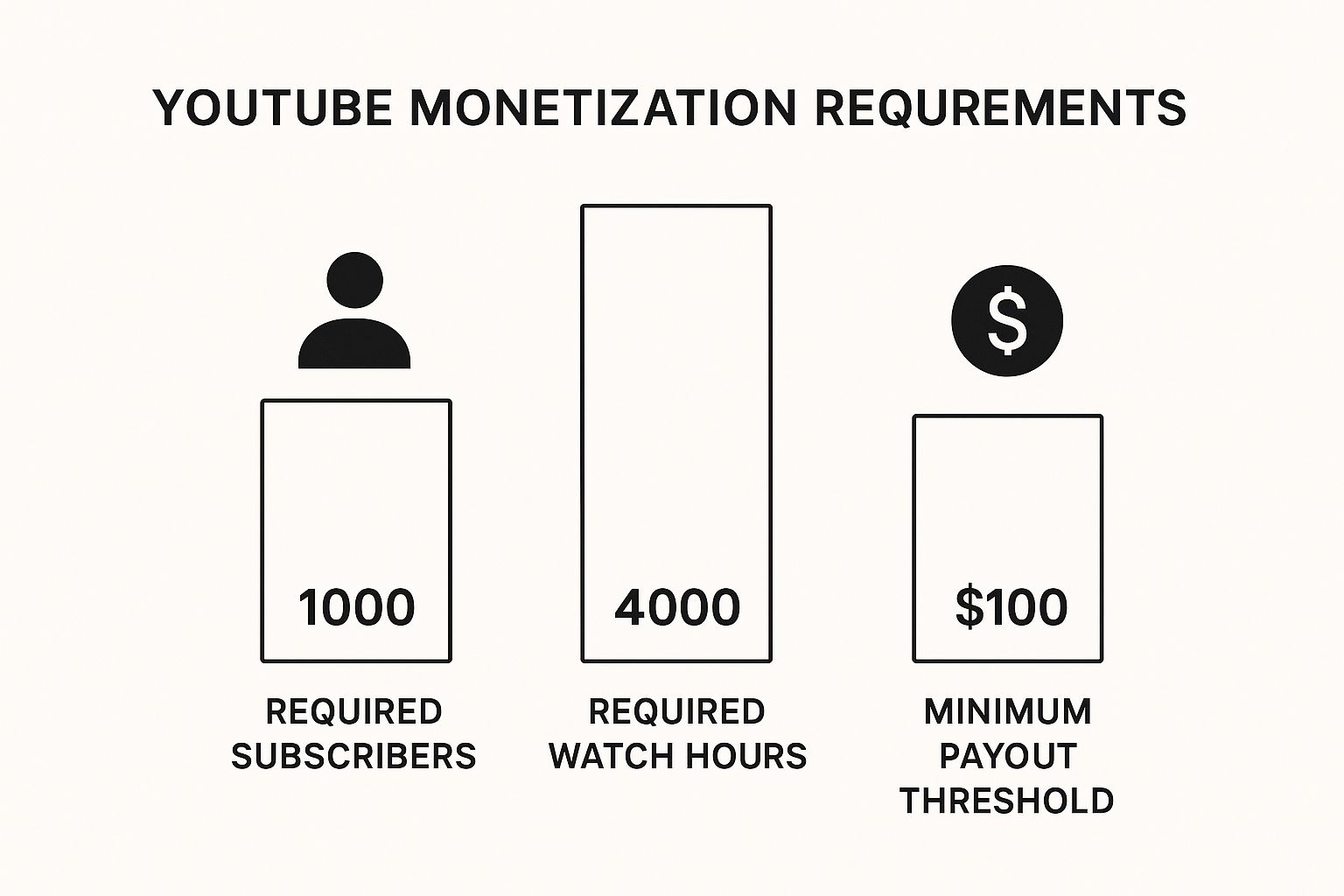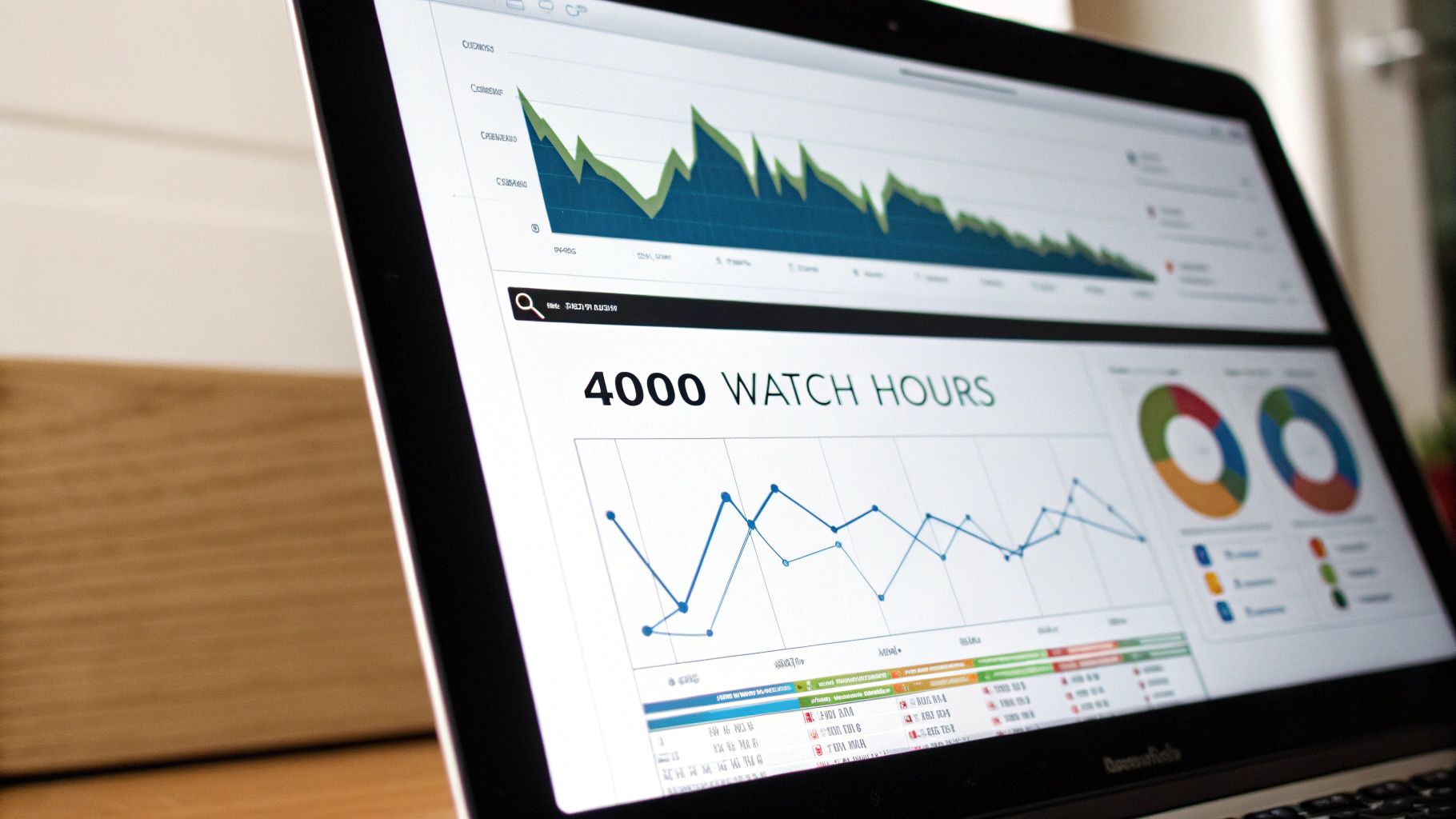So, you want to get paid for your YouTube videos? Fantastic. The first gate you need to pass through is getting into the YouTube Partner Program, or YPP. It’s the official club for creators who want to earn money on the platform.
The magic numbers to get in are 1,000 subscribers and 4,000 hours of public watch time over the last 12 months.
Alternatively, if you're all about that short-form life, you can qualify with 1,000 subscribers and 10 million valid public Shorts views in the last 90 days. Nail one of those combos, and you're on your way.
Your Quick Guide to YouTube Monetization
Think of these requirements less as a hurdle and more as a proving ground. YouTube wants to see that you've built a real community that actually wants to watch your stuff. When you hit these numbers, you're not just a creator; you're a creator with an audience that advertisers are interested in.
YouTube has actually created a couple of different ways to get your foot in the door, depending on whether you're a long-form video guru or a Shorts wizard. This is great because it lets you focus on the content style you love most.
Let's break down the main entry points.

As the visual shows, it all starts with building that core following (1,000 subscribers) and proving your content has staying power (4,000 watch hours). Only after you've crossed that bridge can you even start thinking about hitting the $100 payout threshold to get that first check.
Getting those initial subscribers can feel like a slow grind. Many creators look for a little push to get the ball rolling, and some buy YouTube subscribers to build that initial momentum. This can free you up to focus on the most important part: making killer videos people can't stop watching.
YouTube Partner Program Eligibility Pathways
To make it even clearer, YouTube now has two main tiers for monetization. The first gets you access to things like Super Chat and channel memberships, while the second unlocks the big one: ad revenue.
Here's a simple breakdown of how they compare:
| Requirement | Fan Funding Tier | Full YPP (Ad Revenue) |
|---|---|---|
| Subscribers | 500 | 1,000 |
| Public Watch Hours | 3,000 (in last 12 months) | 4,000 (in last 12 months) |
| Shorts Views | 3 million (in last 90 days) | 10 million (in last 90 days) |
| Recent Uploads | 3 public uploads (in last 90 days) | 3 public uploads (in last 90 days) |
Hitting the "Fan Funding Tier" is a great first step that lets your most loyal fans support you directly. Once you're in, you can keep growing toward the full YPP requirements to unlock every monetization feature YouTube has to offer.
Building Your Community and Watch Time
Let's be real: hitting YouTube's monetization numbers isn't just about chasing stats. It's about building a tribe. Think of your subscribers as your ride-or-die crew—the people who hit that subscribe button not by accident, but because they genuinely love what you're putting out there. The real goal is to create content so good, so useful, or so entertaining that subscribing becomes a total no-brainer.
This all comes down to making videos that actually do something for the viewer. Solve a problem they have. Make them laugh after a long day. Show them a perspective they've never seen before. When you forge that connection, they’ll stick around for the long haul.
Mastering the Art of Watch Time
If subscribers are your foundation, then watch hours are the lifeblood of your channel. This is the magic metric that screams to the YouTube algorithm, "Hey, people don't just click my videos—they actually watch them!" It’s not about pumping out three-hour epics, but about becoming a master storyteller who can keep people glued to the screen from the opening scene to the final credit.

The good news? YouTube recently lowered the velvet rope. For creators in the UAE and other MENA countries, there's a new entry point: you can start monetizing with just 500 subscribers and 3,000 public watch hours in a year. This is a game-changer, making it way easier to get your foot in the door and start earning. You can learn more about YouTube's expanded monetization tiers in the MENA region.
Still, racking up thousands of hours can feel like trying to climb a mountain in flip-flops. It all comes down to being strategic.
Key Takeaway: You have about 15 seconds to win or lose. The start of your video is everything. Hook them with a burning question, a wild statement, or a sneak peek of the epic final result. Don't give them a reason to click away.
For creators who want to fast-track their journey, some services can give you a major leg up. If you're eager to get monetized, you can explore options to reach the 4000-hour milestone faster.
But at the end of the day, nothing beats a steady stream of killer content. Here are a few tricks of the trade to boost both your subscriber count and watch time:
- Create Video Playlists: Think of these as curated mixtapes. Grouping related videos together is the easiest way to turn a single view into a full-on binge session.
- Use Engaging End Screens: Don't just let your video fade to black! Use those final seconds to point viewers directly to another one of your awesome videos.
- Become an Analytics Nerd: Dive into your "Audience Retention" reports in YouTube Studio. Find out exactly where people are bailing on your videos and figure out why. This is gold.
Racking Up Views with YouTube Shorts

Does producing long-form content feel like training for a marathon you never signed up for? Well, I've got good news. The absolute explosion of YouTube Shorts has opened up a brand new, high-speed lane on the road to getting paid. This path trades the slow-and-steady grind for watch hours for the blink-and-you'll-miss-it potential of viral views.
To get into the YouTube Partner Program this way, you still need those 1,000 subscribers. But instead of watch hours, you need 10 million valid public Shorts views in the last 90 days for the full ad revenue deal. There's also an earlier entry point: hit 3 million views to unlock Fan Funding features. This is a total game-changer for creators who are all about fast, punchy, and attention-grabbing content.
So, what’s a “valid” view? It's just a view from someone who watches your video in the Shorts feed. Simple as that. We're not worried about watch time here; it’s all about a massive volume of eyeballs and engagement.
Cracking the Shorts Code
Here's a secret: going viral on Shorts is rarely just luck. It's about understanding the unique playbook for this format. The algorithm loves content that delivers an instant hit of dopamine and keeps people stuck in a swiping loop. Think of every Short as a tiny little story with a beginning, a middle, and a hook at the end that makes people immediately rewatch it.
The creators who are absolutely crushing it with Shorts are usually leaning on a few key tactics:
- Ride the Wave: Jump on trending audio, challenges, and popular effects without hesitation. Using a hot sound is like giving your video a little algorithmic booster rocket.
- Create Infinite Loops: This is a clever one. Edit your Short so the end flows seamlessly back into the beginning. This little trick can send your view count to the moon as people rewatch it two or three times before they even realize what happened.
- Deliver a Fast Punchline: The first three seconds are everything. You have to hook them instantly. Start with a wild visual, a controversial statement, or a question they just have to see answered.
A huge piece of the Shorts puzzle is pure volume. A long-form video might be a big weekly project, but the top Shorts creators are often posting multiple times a day. It's all about maximizing your chances of hitting the algorithmic jackpot.
This high-frequency style gives you a ton of data on what your audience actually wants, letting you adjust your strategy on the fly. By going all-in on a high-impact, high-volume Shorts plan, you can blow past those monetization requirements way faster than you might think. Before you know it, those quick clips can start building a real income stream.
So, You Hit the Numbers… Now For the Real Test
Getting those subscribers and watch hours feels like passing the big exam, right? But hold on—that just gets you to the front door. Now, you’ve got to prove you know how to behave once you're inside. This is where YouTube's monetization policies come into play, and trust me, they are not optional reading.
Think of them as the unspoken "house rules" for earning money on the platform. Ignoring them is the quickest way to get your application denied or, even worse, get demonetized down the road. This isn't just about avoiding a slap on the wrist; it's about building a channel that brands and YouTube itself can stand behind.
The Three Commandments of Monetization
YouTube's rulebook can look like a legal document designed to put you to sleep, but it really boils down to three main areas. If you're serious about making money, you need to know these inside and out.
-
Community Guidelines: This is the big one—the fundamental law of the land. It covers everything from spammy behavior and scams to sensitive or harmful content. A serious violation here won't just cost you monetization; it can get your whole channel deleted. No joke.
-
AdSense Program Policies: This is all about the money. These rules are designed to keep the ad system fair and prevent fraud. It's where you'll find the nitty-gritty on things like invalid clicks and the dreaded "reused or repetitious content" policies.
-
Advertiser-Friendly Content Guidelines: This one decides which of your videos actually get to run ads. You might have a video that's perfectly fine by the Community Guidelines, but if it's full of profanity, controversial topics, or shocking stuff, advertisers will run for the hills, and your video won't earn a dime.
Let's break it down with an analogy. Imagine your channel is a new restaurant. The Community Guidelines are the health and safety codes you must follow to stay open. The AdSense policies are your business license and tax rules. And the advertiser-friendly guidelines are about keeping the place clean and having a good atmosphere so customers (advertisers) actually want to come in.
Failing to understand these youtube monetization requirements is the number one reason I see creators with great numbers get rejected. The human review team at YouTube is looking for more than just views; they want to see a channel that adds something valuable to the platform.
They're looking for an authentic creator. They'll scrutinize your most popular videos, your video descriptions, your thumbnails—everything—to make sure you're the real deal. If your channel is just a collection of stitched-together clips or auto-generated slideshows, you're going to have a bad time.
Cashing In: What's Your Earning Potential in the UAE?
Alright, you’ve jumped through the hoops and finally qualified for YouTube monetization. Awesome! Now for the best part: getting paid. As a creator in the UAE, you’re sitting in one of the hottest digital markets on the planet. But what does that actually mean for your wallet?
To figure that out, you need to get friendly with two little acronyms that every serious YouTuber lives by: CPM and RPM.
Think of CPM (Cost Per Mille) as what advertisers are willing to bid for 1,000 ad impressions on your videos. A high CPM means brands see your audience as a premium one. Then there's RPM (Revenue Per Mille), which is the number you really care about. It’s the cash you actually pocket for every 1,000 video views after YouTube takes its share.

Why the UAE Is a Goldmine for Creators
Here’s where it gets really good for local creators. Your channel's profitability is tied directly to those CPM rates, and the UAE has some of the highest in the world. Why? It's simple, really. The region has a booming economy, which means advertisers have deeper pockets and are willing to spend more to reach the right people.
This gives creators targeting UAE audiences a massive head start over those in countries with lower CPMs. You can see a full breakdown of how much YouTube CPM rates vary by country to get the bigger picture.
This high earning potential means that content centered on luxury, finance, real estate, or tech—topics that naturally attract a high-income audience—can be incredibly profitable here.
Pro Tip: Don't just glance at your RPM. Treat it like a report card for your content. If that number is climbing, it’s a great sign that you're making videos that both attract big-spending advertisers and keep viewers hooked long enough to watch the ads.
To truly capitalize on this, you need to live in your YouTube Analytics. Seriously. Digging into your audience demographics and seeing which videos pop off is the secret to refining your strategy for maximum cash. If you need help, our guide on the best social media analytics tools is a great place to start.
And don't forget, stories about life, business, and culture in the UAE have a huge global appeal. Your content can easily pull in a massive international audience, pushing your income even higher and opening up a world of financial opportunity.
Common YouTube Monetization Questions
https://www.youtube.com/embed/FLXMyKixqdg
Trying to figure out YouTube monetization can feel like you’ve been handed a map with half the directions missing. It’s a common feeling, so let's clear up some of the fog and answer the questions that trip up most creators.
One of the first hurdles is simply where you live. Yes, you absolutely must live in a country or region where the YouTube Partner Program is available. The good news is the list is pretty long these days, and creators in places like the UAE are definitely on it.
What Happens If You Get Rejected?
Getting that "not approved" email stings, but it’s not a dead end. Think of it as a detour, not a stop sign. YouTube will give you a general reason, usually pointing you toward a violation of their Community Guidelines or AdSense policies.
Don't sweat it. You get a do-over. You can re-apply 30 days after receiving the rejection notice. Use that month to be brutally honest with yourself—go through your channel, clean up any questionable content, and make sure you’re playing by the rules.
Another big point of confusion is what actually counts toward those magic numbers.
Only watch hours from public videos are counted toward the YPP threshold. Any time accumulated on private, unlisted, or deleted videos won't help you meet the YouTube monetization requirements. Views from ad campaigns are also excluded.
The creator world is always shifting. The Partner Program first landed in the UAE back in 2012, and it’s a completely different beast now. Today, around 7.5 million adults in the UAE are on the platform. And here’s the wild part: over 95 percent of the watch time for channels based in the UAE comes from viewers outside the country. It just goes to show that local stories can have massive global appeal. You can read more about the rise of UAE YouTube creators on Arab News.
Ready to grow your channel and meet those requirements faster? Socialbuss provides the tools you need to boost your presence and build a thriving community. Explore our services at https://www.socialbuss.com.
